Surfe Alternatives
A direct comparison of 10 Surfe alternatives. This guide analyzes features, pricing, and integrations to help you choose the right tool.

Surfe is a popular choice for good reason. It excels at adding contacts from LinkedIn directly to your CRM. Many teams use it to build their sales pipeline without leaving LinkedIn, which saves a lot of time and keeps workflows simple.
But like any tool, it has limits. Some users find the pricing a bit steep for smaller teams, while others wish for more advanced features. We analyzed the top alternatives to help you find a better fit for your needs. Let's get started.
Consider 11x for Your Sales Team
For teams interested in digital workers for sales, 11x is a relevant option. It offers autonomous agents that manage tasks like prospecting and outreach. This allows you to delegate specific functions and may be a good fit for your operational goals.
11x is a GTM platform that uses AI agents to manage the sales process. An agent named Alice finds prospects, runs outreach, and updates the CRM. Julian qualifies inbound leads and books meetings. The platform unifies tools for data enrichment, outreach, and email warmup.
Surfe Alternatives
This section breaks down the top Surfe alternatives. We compare each tool's pricing, main features, and its specific advantages and drawbacks against Surfe to help you decide.
1) Apollo.io
Apollo.io is an all-in-one sales platform. It combines a large B2B database with built-in tools for outreach and analytics. This allows teams to find prospects and engage them from a single interface, without relying only on external sources like LinkedIn.
Unlike Surfe, which primarily syncs LinkedIn contacts to a CRM, Apollo.io is a self-contained system. It offers its own database and engagement features, making it a more extensive solution rather than a simple connector tool for your existing workflow.
Teams that need a single platform for data, prospecting, and outreach may find Apollo.io a better fit. It can replace separate tools for lead generation and email sequencing, which can consolidate the sales stack into one subscription.
Some users report that contact data can occasionally be outdated, requiring manual verification. The platform's wide range of features might also be complex for teams that only need a simple contact-syncing tool similar to Surfe.
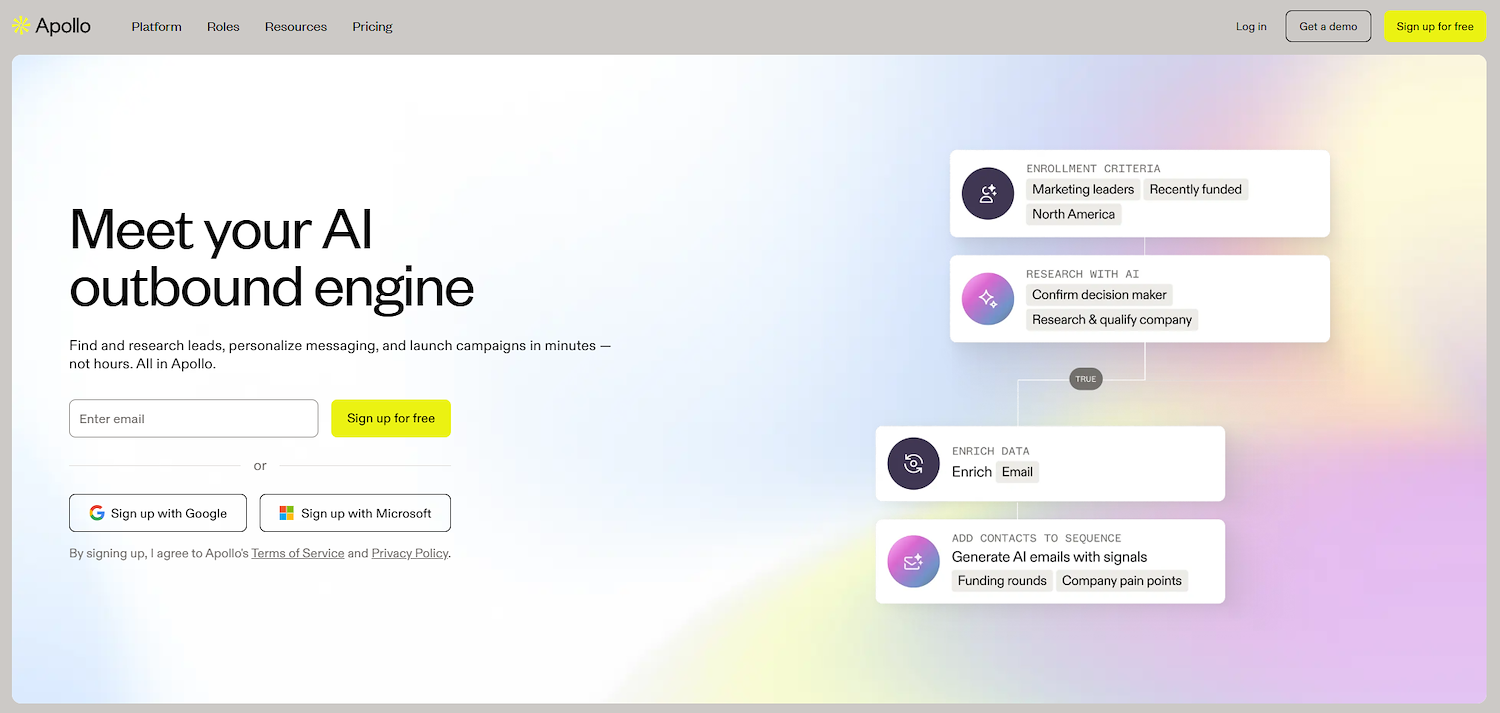
Apollo.io is an all-in-one sales platform with a B2B database and tools for outreach and analytics. Teams use it to find and engage prospects from a single interface. Unlike Surfe, it is a self-contained system with its own database, not just a tool to sync LinkedIn contacts to a CRM.
It can replace separate tools for lead discovery and email sequences. Some users note its contact data can occasionally be outdated.
Apollo.io's Main Features
- Accesses a B2B database with contact information for prospecting.
- Automates outreach using a sequencing engine for multi-step campaigns.
- Provides analytics to measure email performance and sales activities.
- Enriches existing CRM data with firmographic and demographic details.
How Apollo.io Compares to Surfe
Average Review score: 4.7/5 stars based on 8,904 G2 reviews.
- Apollo.io provides its own B2B database of over 210 million contacts. This means you are not limited to LinkedIn to find prospects, which is the primary source for Surfe.
- It combines tools for prospect discovery, engagement, and analytics in one platform. Surfe, in comparison, focuses on the connection between LinkedIn and your CRM, which may require other sales tools.
- The platform includes a native sequencing engine to automate outreach campaigns. This is a built-in feature, while Surfe requires integration with other tools for similar automation.
- Apollo.io offers a free plan for individual users. This makes it more accessible for small-scale use than Surfe, whose plans some smaller teams find steep.
Apollo.io's Drawbacks Compared to Surfe
- Surfe provides a more focused experience on LinkedIn, as it is built to work directly on the platform. In comparison, some users find Apollo.io's extension less integrated because its primary focus is its own database.
- The tool's wide range of features can create a learning curve for teams that only need to sync contacts. Surfe has a simpler, more direct function that is often easier to adopt for this specific task.
- Data management between Apollo.io and an existing CRM can sometimes be complex. Surfe's approach is more straightforward; it sends data from LinkedIn directly to the CRM without an intermediate database.
- Apollo.io's database information can sometimes be out of date, which may require manual verification. Surfe pulls data from live LinkedIn profiles, which are often more current.
Pricing and Plan Comparison
Apollo.io provides a free plan for a single user, and its paid plans start at $49 per user per month. This pricing structure, especially the free tier, makes it a more accessible starting option compared to Surfe, which does not offer a free version.
2) Lusha
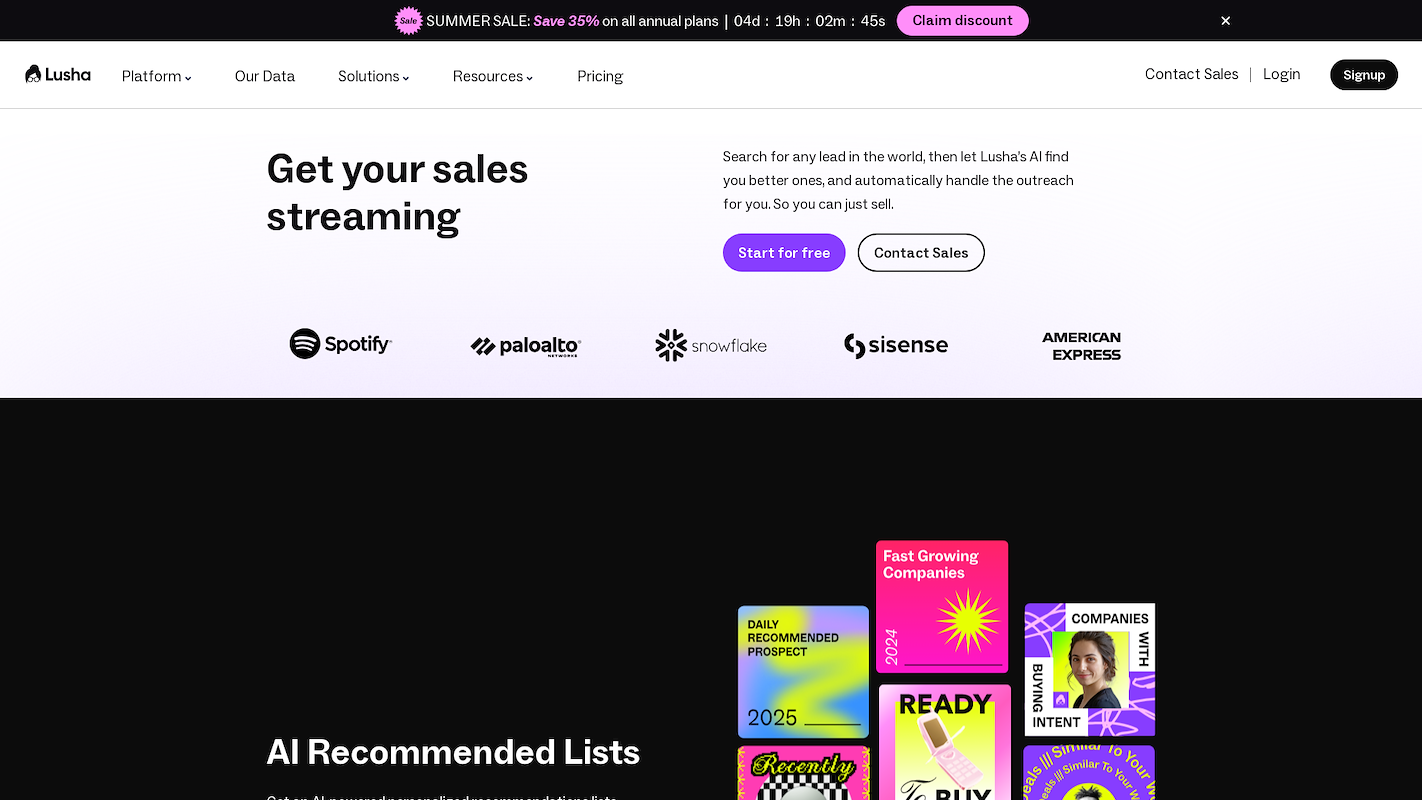
Lusha is a sales intelligence platform for global B2B lead discovery. It provides AI-based prospect recommendations and automates multichannel outreach within a single workflow. The platform emphasizes data compliance with standards like GDPR and CCPA, and integrates with popular CRMs and sales tools so reps can focus on sales.
Teams use it to build accurate prospect lists and receive new, matched leads. An extension captures contact data from LinkedIn and the web. The system also automates personalized email sequences to improve reply rates and enriches existing CRM records to keep data current.
Lusha's Main Features
- Delivers AI-recommended lists of prospects based on an ideal customer profile and offers live playlists that automatically update with new leads.
- Identifies in-market buyers and provides real-time notifications based on specific intent triggers.
- Automates personalized email sequences using AI-generated copy to engage with potential customers.
- Records and analyzes sales meetings to provide data and insights from conversations.
How Lusha Compares to Surfe
Average Review score: 4.3/5 stars based on 1,516 G2 reviews.
- Lusha offers its own B2B contact database, which gives you an alternative to LinkedIn for prospecting. Surfe, in comparison, focuses on extracting contact information directly from LinkedIn profiles.
- It uses AI to automatically generate and refresh prospect lists based on your ideal customer profile. This differs from Surfe, where you manually build your pipeline by visiting LinkedIn profiles.
- The tool provides a free plan with limited credits, making it accessible for individual users or small-scale tests. Surfe does not offer a free version, and its paid plans can be steep for smaller teams.
- Lusha specializes in finding verified direct-dial phone numbers and email addresses. This is a slight difference from Surfe, which syncs the contact information available on a person's LinkedIn page.
- The platform identifies buyers who show intent signals, helping you prioritize outreach. Surfe does not include a native buyer intent feature; it focuses on contact extraction.
Lusha's Drawbacks Compared to Surfe
- Lusha's workflow often directs users toward its own platform features. This is a different approach from Surfe, which is designed to keep the entire prospecting process within the LinkedIn interface.
- The platform relies on its own database, so some users report that contact details can be outdated. Surfe sources its data directly from live LinkedIn profiles, which are generally more current.
- Its wide range of features can be complex for teams that only need to sync contacts. Surfe provides a more direct function for this specific task, which is often easier to adopt.
Pricing and Plan Comparison
Lusha offers a free plan and paid tiers starting at $36 per user per month. In contrast, Surfe does not offer a free version, making Lusha a more accessible entry point for individuals or small teams.
3) ZoomInfo SalesOS
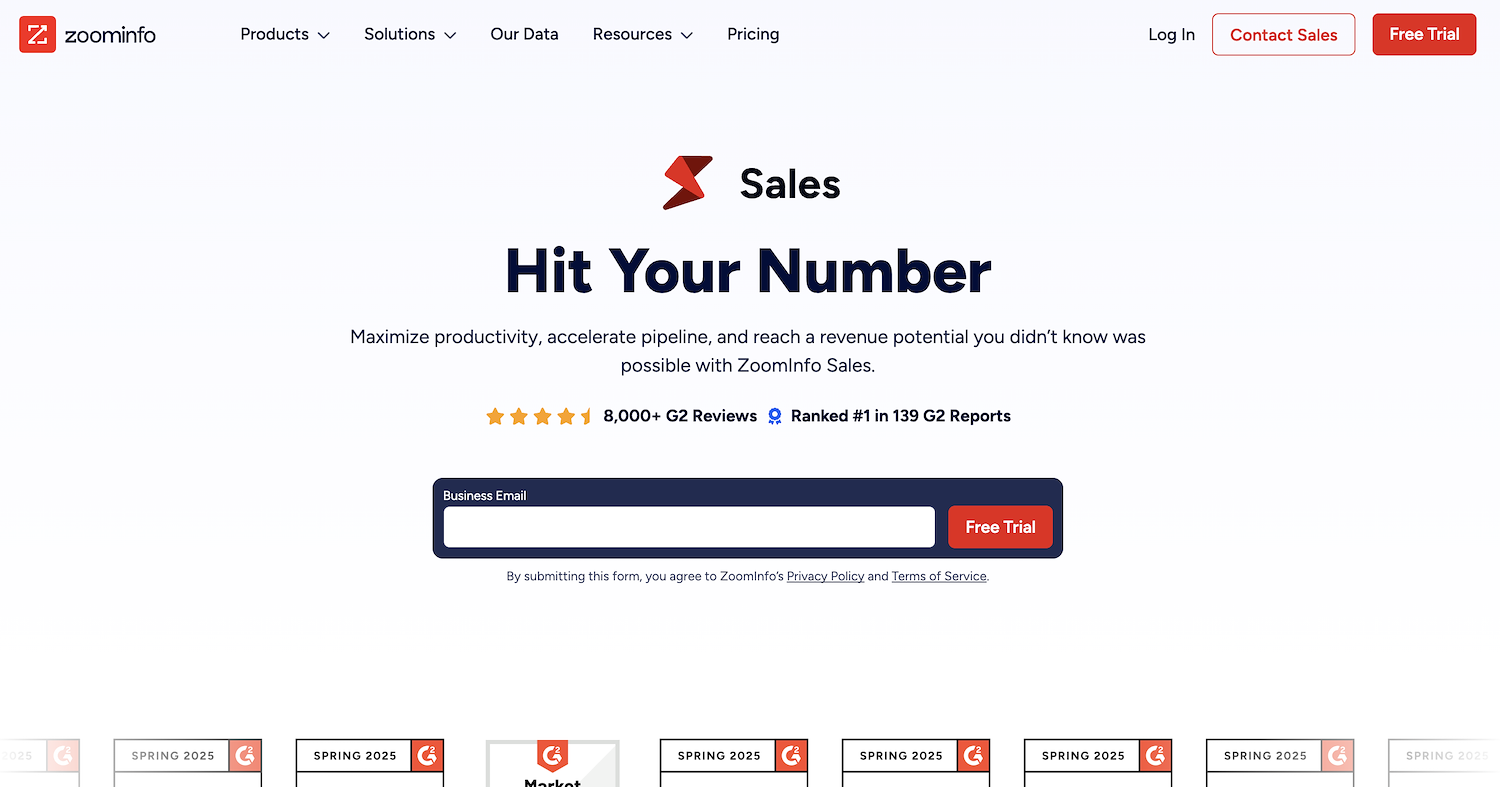
ZoomInfo SalesOS is a go-to-market platform that provides B2B intelligence and engagement software. It offers a large contact database to help teams find and connect with decision-makers. The platform identifies prospects who show purchase intent signals, which helps prioritize outreach efforts.
Users can automate outreach through sales plays, and the system supports CRM integration to keep data synchronized. It is a tool for sales teams to build a pipeline and manage their sales process.
ZoomInfo SalesOS's Main Features
- Offers a B2B intelligence database to find contact information for decision-makers.
- Identifies prospects showing purchase intent signals to help prioritize outreach.
- Automates outreach efforts using pre-built or custom sales plays.
How ZoomInfo SalesOS Compares to Surfe
Average Review score: 4.5/5 stars based on 8,738 G2 reviews.
- ZoomInfo SalesOS offers a proprietary B2B database. This means you are not limited to LinkedIn for prospects, unlike Surfe, which operates primarily as a layer on top of LinkedIn.
- The platform identifies buyer intent signals to help teams focus on prospects who are ready to buy. This is a more proactive approach than Surfe's manual contact sync.
- It uses an AI Copilot to provide guided recommendations for outreach. This automates part of the decision process, whereas Surfe requires the user to manually identify and add contacts.
- The tool combines data, engagement, and analytics in a single system. Surfe is a connector, so teams might need additional software for a complete sales workflow.
ZoomInfo SalesOS's Drawbacks Compared to Surfe
- ZoomInfo SalesOS sometimes requires users to switch between its platform and LinkedIn. Surfe, in comparison, operates entirely within the LinkedIn interface, which can create a more focused workflow for some teams.
- The tool's contact data comes from its own database, and some users report that it can be outdated. Surfe pulls information directly from live LinkedIn profiles, which are often more current.
- Its extensive features can be complex for teams that only need a simple contact-syncing tool. Surfe offers a more direct function for this specific task, which is often easier to adopt.
Pricing and Plan Comparison
ZoomInfo SalesOS does not provide public pricing and operates on a custom quote basis, which generally involves annual contracts. This model is geared toward larger teams and differs from Surfe's per-user plans. For specific pricing details, we recommend visiting the ZoomInfo SalesOS's official website.
4) RocketReach
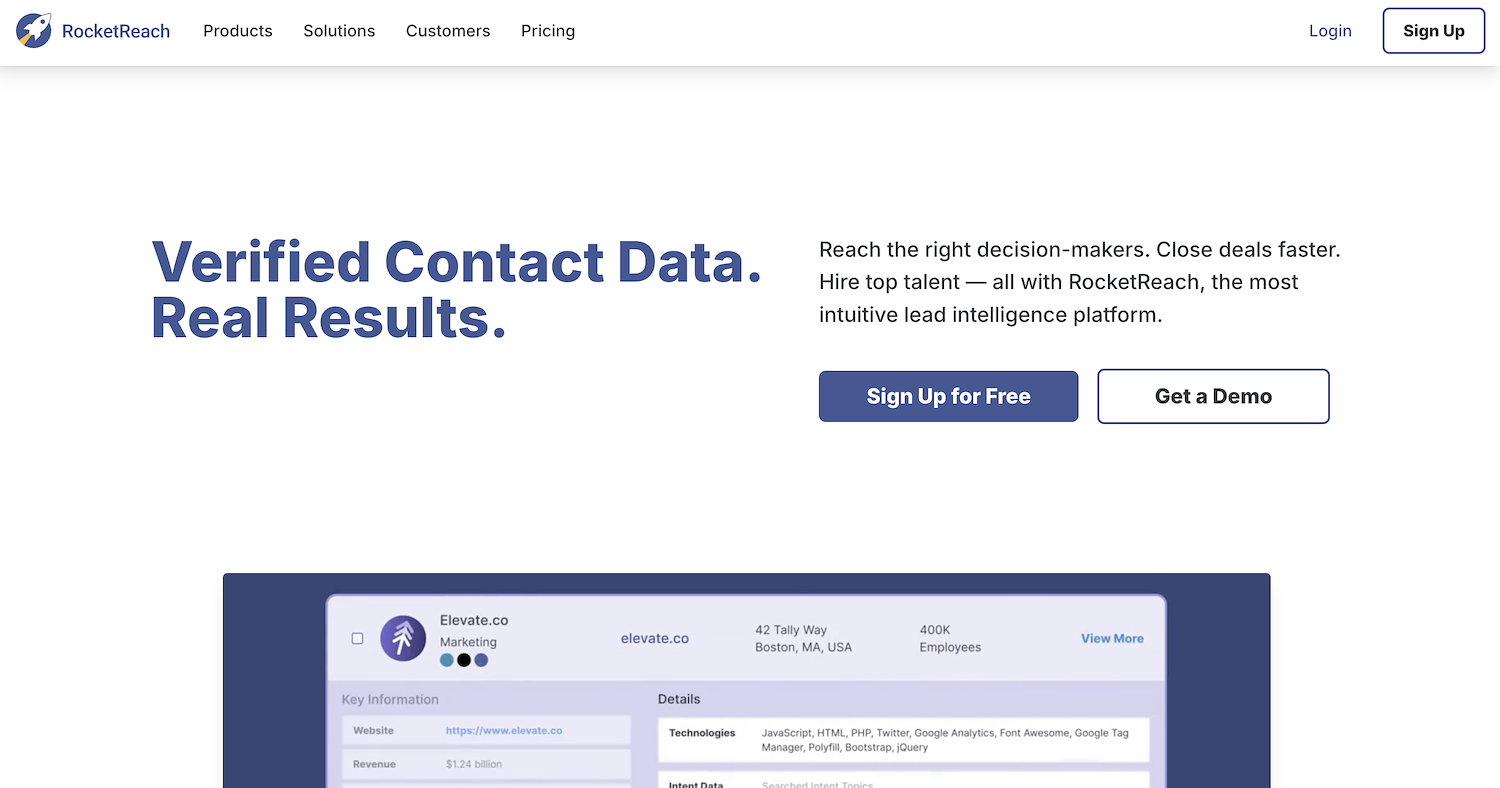
RocketReach is a platform to find contact information for professionals from a large database of verified emails and phone numbers. Sales and recruiting teams use its browser extension to look up contact details from social profiles and company websites. The tool helps build prospect lists for outreach campaigns and enrich CRM data.
RocketReach's Main Features
- Accesses a large database of verified emails and phone numbers for professionals.
- Uses a browser extension to look up contact details from social profiles and company websites.
- Builds prospect lists for outreach campaigns.
- Enriches existing CRM data with new contact information.
How RocketReach Compares to Surfe
Average Review score: 4.4/5 stars based on 918 G2 reviews.
- RocketReach provides access to its own database of over 700 million contacts. This is different from Surfe, which primarily extracts data from live LinkedIn profiles.
- It offers a free plan with a limited number of lookups each month. This makes it more accessible for small-scale use compared to Surfe, which has no free version.
- The tool supports bulk lookups and has an API for custom integrations. This allows for larger-scale data retrieval than Surfe's one-by-one contact syncing from LinkedIn profiles.
- Its database includes specialized contact data for hard-to-reach sectors like healthcare. Surfe's data is more general because it depends on the information available on LinkedIn.
RocketReach's Drawbacks Compared to Surfe
- RocketReach pulls information from its own database, so some contact details might be outdated. Surfe avoids this because it syncs data directly from live LinkedIn profiles, which are generally more current.
- Its workflow sometimes requires users to switch between LinkedIn and the RocketReach platform. Surfe, in comparison, operates entirely inside LinkedIn, which keeps the prospecting process in one place.
- The platform's extensive features, like bulk lookups, can be more than what a team needs for simple contact syncing. Surfe offers a more direct tool for this specific task, which can be easier to adopt.
Pricing and Plan Comparison
RocketReach has a free plan and paid options starting at $99 per month for 100 lookups. In contrast, Surfe does not offer a free version, making RocketReach a more accessible entry point for individuals or small teams.
5) Wiza
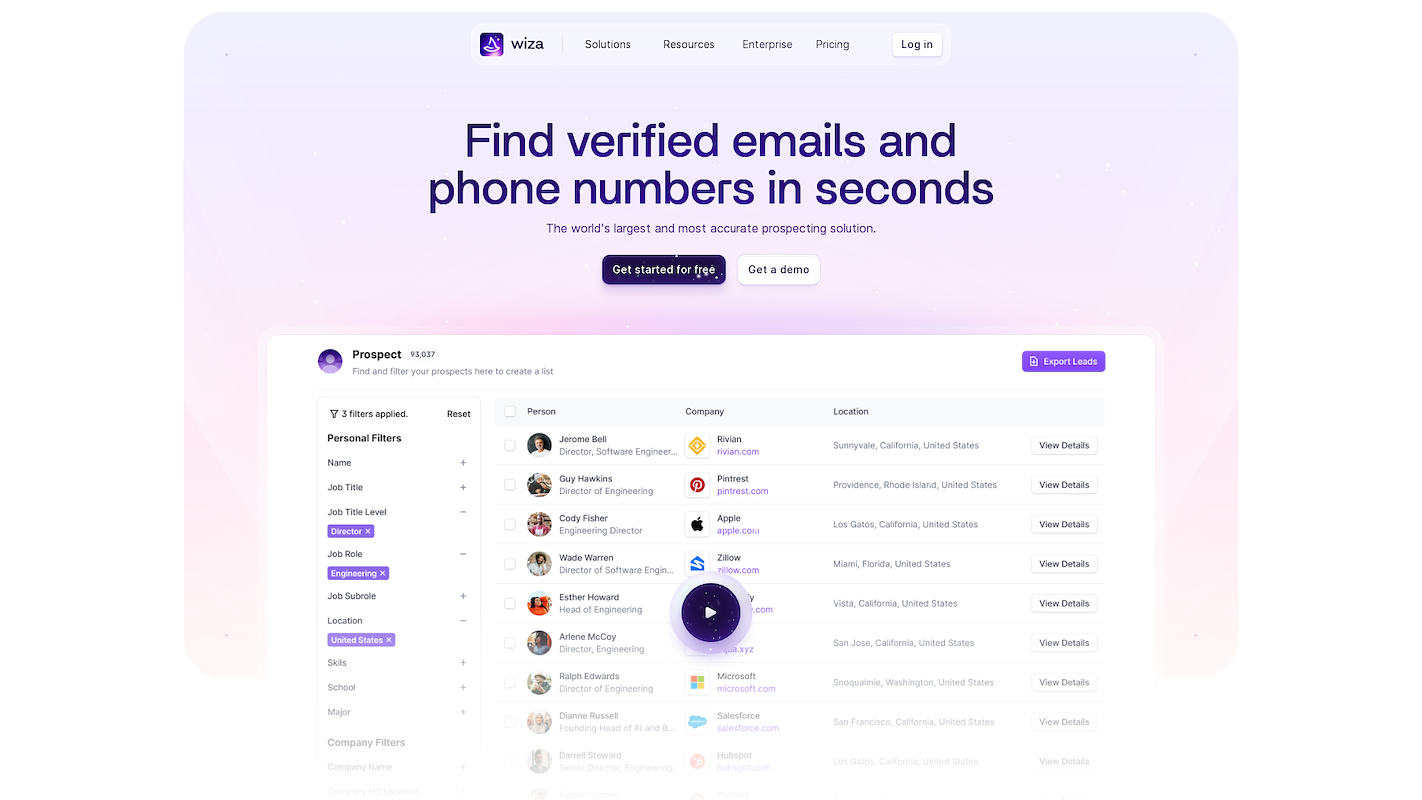
Wiza is a sales intelligence tool built for LinkedIn outreach. It allows sales teams to find prospect contact details directly from LinkedIn profiles. The platform then exports this data to a CRM, which supports the creation of targeted sales campaigns without extra manual entry.
Wiza's Main Features
- Performs live data checks at the moment of request to ensure fresh contact information.
- Includes built-in email verification with 99%+ deliverability and consumes credits only for valid emails.
- Enriches data with over 30 additional fields, such as company revenue, funding, and headcount.
- Offers a monitoring feature to track prospect job changes for timely outreach.
How Wiza Compares to Surfe
Average Review score: 4.5/5 stars based on 710 G2 reviews.
- Wiza includes a built-in email verification system and only uses a credit for a valid email. Surfe syncs the contact information as it appears on LinkedIn, without a separate, built-in verification step.
- The tool enriches contact data with over 30 additional fields, such as company revenue and funding. In comparison, Surfe primarily syncs the standard information available on a LinkedIn profile.
- It offers a monitoring feature that tracks when prospects change jobs, which allows for timely outreach. Surfe does not have a native feature for tracking job changes automatically.
- Wiza provides a free plan for individual users. This makes it more accessible for small-scale use than Surfe, which does not offer a free version.
Wiza's Drawbacks Compared to Surfe
- Wiza's workflow sometimes requires users to switch between its platform and LinkedIn. Surfe, in contrast, is designed to keep the entire prospecting process within the LinkedIn interface, which can be simpler for some teams.
- The tool's focus is on data extraction and verification. This is different from Surfe, which offers a more integrated experience with features like message templates that work directly on a LinkedIn profile page.
- Its process adds an enrichment step before syncing to a CRM. Some users may prefer Surfe's more direct approach, which sends contact information straight from LinkedIn to the CRM without an intermediate stage.
Pricing and Plan Comparison
Wiza offers a free plan and paid tiers starting at $49 per user per month. This pricing structure makes it a more accessible entry point compared to Surfe, which does not offer a free version and whose plans are often considered steep for smaller teams.
Beyond Contact Syncing: A Look at 11x
The alternatives discussed focus on finding and syncing contact data. 11x offers a different model by providing autonomous agents to run sales tasks. This shifts the focus from data collection to process automation.
If your goal is to automate entire functions like prospecting or lead qualification, 11x is a relevant option. Its digital workers operate as part of your team, allowing you to scale sales operations without a proportional increase in headcount.
For teams exploring how to delegate parts of the sales cycle, 11x provides a concrete example. You can see how its agents handle outreach and CRM updates, which may fit your operational goals.
With 11x, AI agents manage your sales process from start to finish. An agent named Alice finds accounts and runs outreach, while Julian qualifies inbound leads and books meetings. The platform unifies tools for data, intent signals, and email warmup, replacing the need for multiple point solutions.
Book a demo to see the agents in action.
6) Phantombuster
Phantombuster is a data extraction and workflow automation tool. It uses APIs, called "Phantoms," to perform tasks on websites like LinkedIn. Teams use it to scrape profiles, send messages, and automate other repetitive actions, which helps build lead lists and run outreach campaigns.
Unlike Surfe, which focuses on syncing contacts from LinkedIn to a CRM, Phantombuster is a broader automation platform. It is not limited to contact extraction and can be configured for a wide range of tasks across different social media platforms and websites.
Phantombuster's Main Features
- Extracts data from websites and social media platforms, including LinkedIn, to build custom lead lists.
- Automates actions such as sending connection requests, liking posts, and writing personalized messages.
- Chains multiple automations together into sequences, called "Flows," to create complex workflows.
- Schedules automations to run automatically from the cloud at specific times.
How Phantombuster Compares to Surfe
Average Review score: 4.3/5 stars based on 169 G2 reviews.
- Phantombuster offers automation for a wide range of platforms, not just LinkedIn. This makes it a more versatile tool for general data extraction, while Surfe is built specifically for LinkedIn-to-CRM workflows.
- It allows users to build complex, multi-step automation sequences. Surfe provides a more direct, single-purpose function for adding contacts to a CRM, which requires less setup.
- Automations run from the cloud, so they can be scheduled to execute even when your computer is off. Surfe's extension operates within your browser during active use.
- Phantombuster offers a free trial and a plan with limited execution time. This provides a way to test the service, whereas Surfe does not have a free version.
Phantombuster's Drawbacks Compared to Surfe
- Using automation tools on platforms like LinkedIn can carry some risk to your account if usage limits are exceeded. Surfe's approach is often seen as safer because it focuses on manual, one-by-one actions.
- The platform can have a steeper learning curve. Setting up Phantoms and Flows requires more technical configuration than Surfe's straightforward, browser-based interface for contact syncing.
- It operates as a separate platform that interacts with LinkedIn, rather than a tool embedded in the user interface. Surfe provides a more integrated experience directly on LinkedIn profiles.
Pricing and Plan Comparison
Phantombuster offers a free trial and paid plans starting at $69 per month. Its pricing is based on monthly execution time and the number of automations used. This usage-based model differs from Surfe's per-user subscription and may be a better fit for specific automation needs.
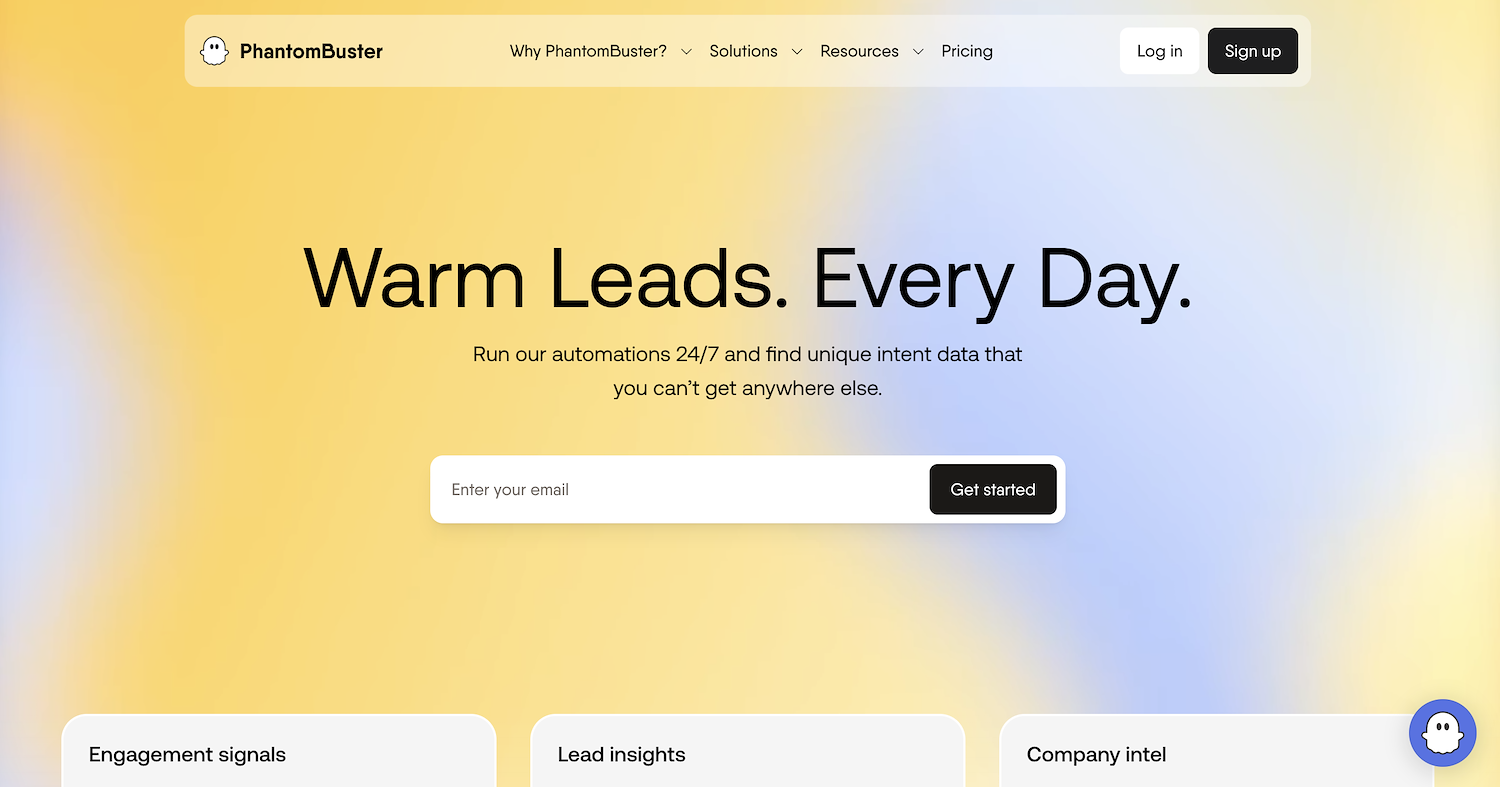
Phantombuster is a data extraction and workflow automation tool. It uses APIs, called "Phantoms," to scrape profiles, send messages, and automate actions on websites like LinkedIn. Teams use it to build lead lists for outreach campaigns and can configure it for various tasks across many platforms.
Phantombuster's Main Features
- Extracts data from websites and social media platforms, including LinkedIn, to build custom lead lists.
- Automates actions such as sending connection requests, liking posts, and writing personalized messages.
- Chains multiple automations together into sequences, called "Flows," to create complex workflows.
- Schedules automations to run automatically from the cloud at specific times.
How Phantombuster Compares To Surfe
Average Review score: 4.3/5 stars based on 97 G2 reviews.
- Phantombuster extracts data from multiple platforms like Twitter and Google Maps, while Surfe works exclusively within LinkedIn.
- It lets users build complex automation workflows. Surfe, in comparison, has a single-purpose function to add contacts to a CRM.
- The tool's automations run from the cloud on a set schedule. This is different from Surfe's extension, which requires an active browser to operate.
- A free trial is available to test the service. Surfe, in contrast, does not offer a free version of its tool.
Phantombuster's Drawbacks Compared To Surfe
- Using automation tools like Phantombuster can sometimes put a LinkedIn account at risk if usage limits are exceeded. Surfe's approach is often seen as safer because it focuses on manual, one-by-one actions.
- The platform can have a steeper learning curve. Setting up its "Phantoms" and "Flows" requires more technical configuration than Surfe's straightforward, browser-based interface for contact syncing.
- It operates as a separate platform that interacts with LinkedIn, rather than a tool embedded in the user interface. Surfe provides a more integrated experience directly on LinkedIn profiles.
Pricing and Plan Comparison
Phantombuster offers a free trial and paid plans starting at $69 per month. Its pricing is based on monthly execution time and the number of automations used. This usage-based model differs from Surfe's per-user subscription and may be a better fit for specific automation needs.
7) Dux-Soup
Dux-Soup is a LinkedIn automation tool that works as a Chrome extension. It automates actions like visiting profiles, sending connection requests, and messaging prospects. Teams use it to generate leads from LinkedIn without manual intervention.
Unlike Surfe, which focuses on syncing contacts to a CRM, Dux-Soup is built for automating outreach activities directly on LinkedIn. It can run in the background to engage with a target list of profiles, which helps scale lead generation efforts.
Dux-Soup's Main Features
- Automates visiting LinkedIn profiles to generate views and connection opportunities.
- Sends personalized connection requests and direct messages to prospects.
- Tags profiles in LinkedIn to segment lead lists for follow-up campaigns.
- Exports profile data, including email addresses, to a CSV file for use in other systems.
How Dux-Soup Compares to Surfe
Average Review score: 4.4/5 stars based on 131 G2 reviews.
- Dux-Soup automates outreach actions like profile visits and messaging. Surfe, in contrast, is a manual tool for syncing contact data from a profile you are currently viewing.
- It can run in the background to process lists of prospects automatically. Surfe requires active user engagement on each profile to sync information to a CRM.
- The tool offers a free plan for basic profile visiting. This provides an entry point for individual use, while Surfe does not have a free version.
- Dux-Soup focuses on lead generation through automated activity. Surfe's primary function is to act as a data bridge between LinkedIn and a CRM, not to generate engagement.
Dux-Soup's Drawbacks Compared to Surfe
- Automating activity on LinkedIn can carry a risk to your account if not managed carefully. Surfe's manual, one-by-one process is generally considered a safer approach.
- The user interface and setup can be more complex than Surfe. Its focus on automation requires more configuration than Surfe's direct contact-syncing function.
- Dux-Soup operates as an automation engine rather than an integrated part of the CRM workflow. Surfe provides a more direct connection, sending data straight to the CRM.
Pricing and Plan Comparison
Dux-Soup has a free plan for basic automation and paid plans starting at $14.99 per month. Its pricing is based on the level of automation features. This model differs from Surfe's per-user plans, which are focused on CRM integration.
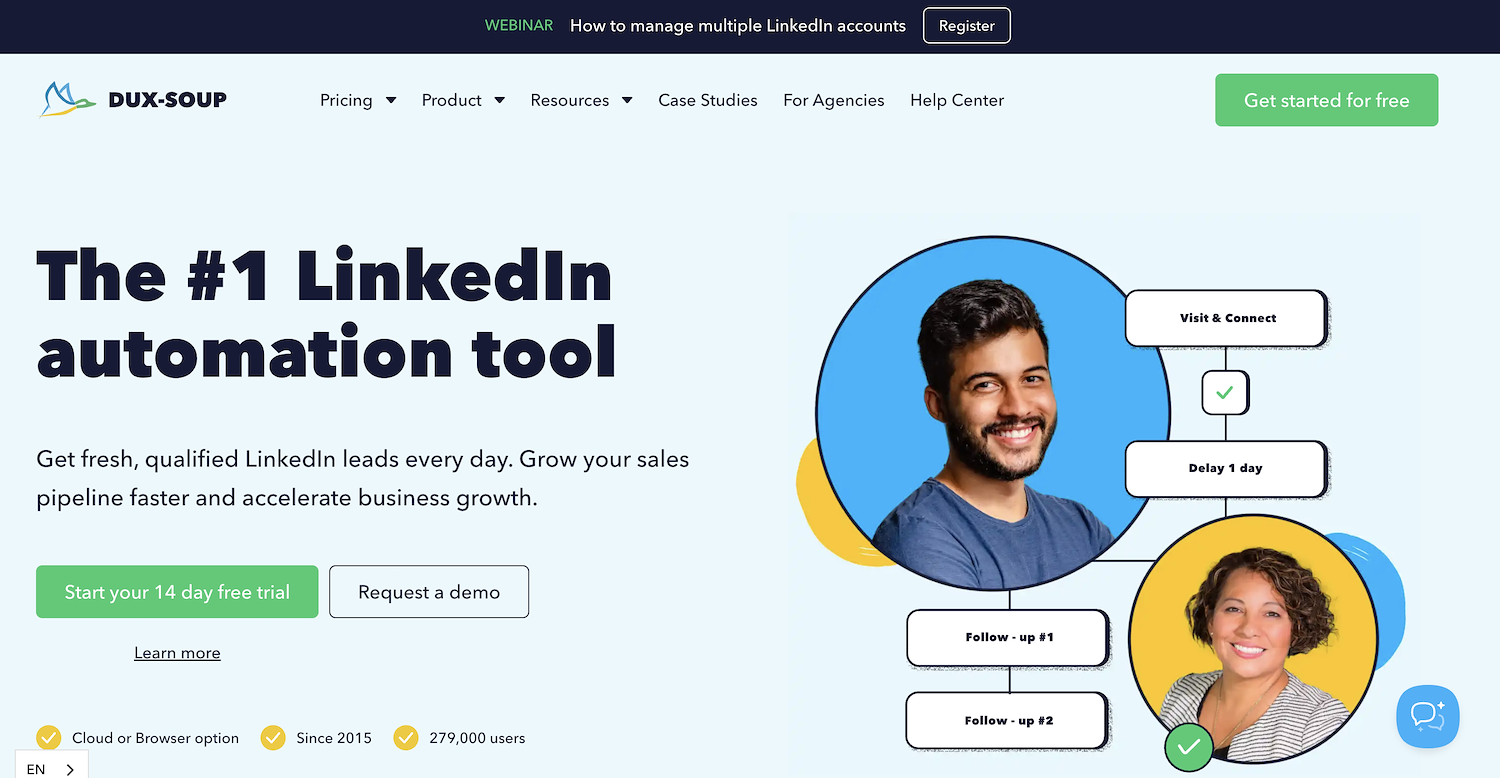
Dux-Soup is a LinkedIn automation tool that works as a Chrome extension. It automates actions like profile visits, connection requests, and messages to prospects for lead generation. Unlike Surfe, which focuses on contact sync, Dux-Soup is built for automated outreach.
The tool can run in the background to engage a target list of profiles and scale outreach efforts.
Dux-Soup's Main Features
- Sends personalized connection invites and messages using drip campaigns with custom time delays.
- Automates engagement by viewing, following, and endorsing prospect profiles.
- Provides a campaign dashboard for performance tracking and automatically stops a sequence when a prospect replies.
- Pushes new leads to CRMs like Salesforce and HubSpot through native integrations or tools like Zapier.
How Dux-Soup Compares to Surfe
Average Review score: 4.3/5 stars based on 82 G2 reviews.
- Dux-Soup automates outreach actions like profile visits and messaging, which is different from Surfe's manual, one-by-one contact syncing.
- It allows you to build automated drip campaigns with custom time delays, a feature Surfe does not offer for multi-step outreach.
- The tool can run in the background to process prospect lists automatically, while Surfe requires active user engagement on each profile.
- A free plan is available for basic automation, making it more accessible for individual use than Surfe, which does not have a free version.
Dux-Soup's Drawbacks Compared To Surfe
- Automating activity on LinkedIn can carry a risk to your account if not managed carefully. Surfe's manual, one-by-one process is generally considered a safer approach that does not put an account at risk.
- The user interface and setup can feel more complex than Surfe. Its focus on automation requires more configuration than Surfe's direct contact-sync function, which is often easier for teams to adopt quickly.
- Dux-Soup operates as an automation engine rather than an integrated part of the CRM workflow. In comparison, Surfe provides a more direct connection, sending data straight from a LinkedIn profile to the CRM.
Pricing and Plan Comparison
Dux-Soup offers a free plan and paid tiers starting at $11.25 per user per month. This makes it a more accessible entry point than Surfe, which does not offer a free version and whose plans are often considered steep for smaller teams.
8) Expandi
Expandi is a LinkedIn automation platform for lead generation. It automates outreach, such as connection requests and follow-up messages. The tool is designed to mimic human behavior to increase safety while it runs campaigns.
Expandi's Main Features
- Automates outreach campaigns on LinkedIn with personalized messages and connection requests.
- Allows image and GIF personalization within LinkedIn messages to increase engagement.
- Builds smart sequences that can include multiple touchpoints and follow-up actions.
- Runs on the cloud, which allows campaigns to operate 24/7 without an active browser.
How Expandi Compares to Surfe
Average Review score: 4.5/5 stars based on 334 G2 reviews.
- Expandi automates outreach, such as messages and connection requests. Surfe is a manual tool used to sync contact data from a profile to a CRM.
- It runs campaigns from the cloud, independent of your browser. Surfe is a browser extension that requires you to be active on a LinkedIn profile to use it.
- The platform's focus is lead generation through automated engagement sequences. Surfe's main function is to simplify data entry from LinkedIn into a CRM.
- Expandi offers features like personalized images in messages. Surfe focuses on data transfer and does not have this type of outreach-specific feature.
Expandi's Drawbacks Compared to Surfe
- The use of automation on LinkedIn may carry some account risk if not configured properly. Surfe's manual process is generally considered to have a lower risk profile.
- The setup of automated campaigns can require more initial configuration than Surfe's direct function to sync contacts, which can be easier for teams to adopt.
- Expandi is a separate platform to manage campaigns. Some users may prefer Surfe's workflow, which is fully integrated within the LinkedIn user interface.
Pricing and Plan Comparison
Expandi's pricing starts at $99 per user per month. It does not offer a free plan, but a 7-day free trial is available. This per-user model is similar to Surfe, but its focus is on automation features rather than CRM integration.
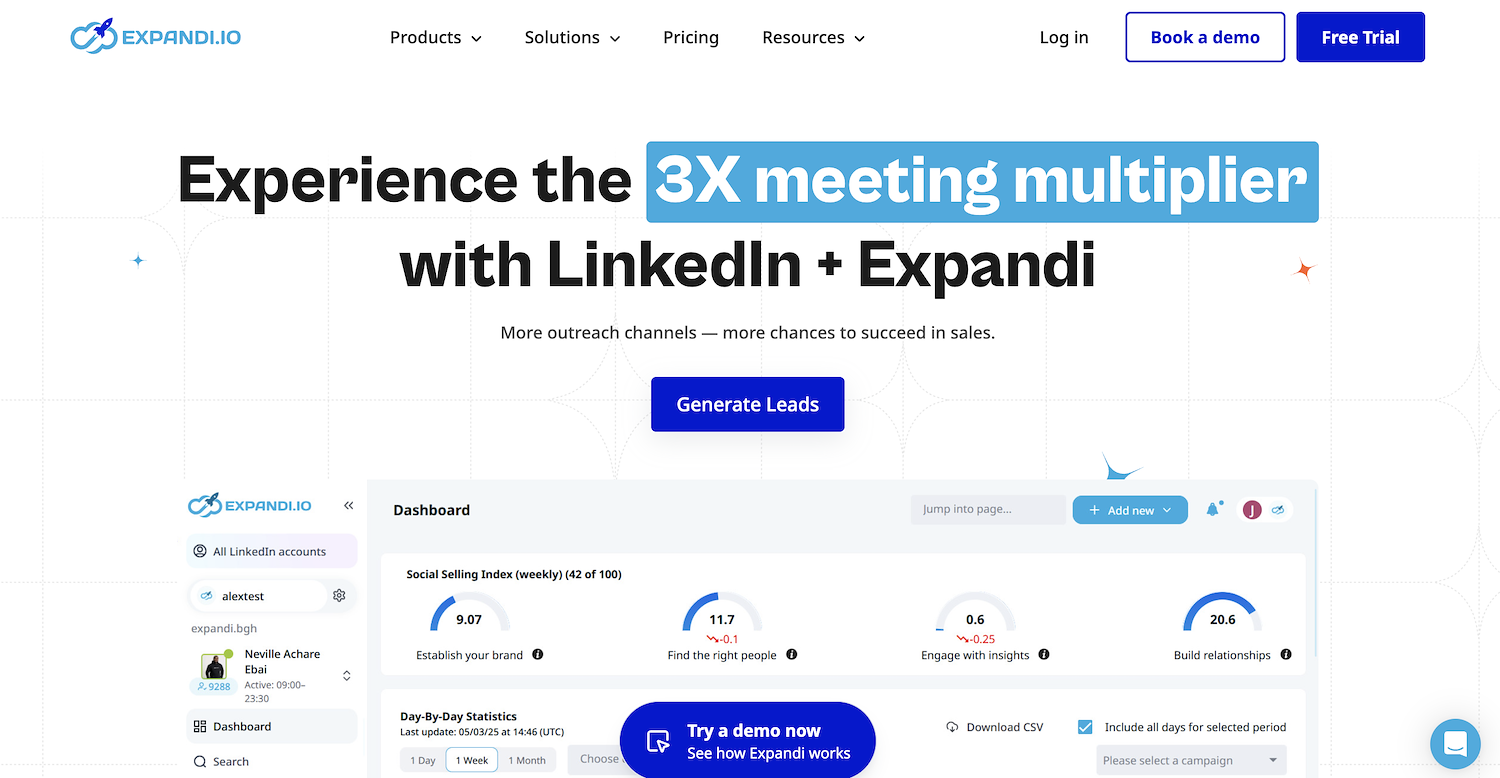
Expandi is a LinkedIn automation platform for lead generation. It automates outreach, such as connection requests and follow-up messages. The tool builds sequences and runs on the cloud, so campaigns can operate 24/7 without an active browser.
It is designed to mimic human behavior for safety and supports image personalization in messages to improve engagement.
Expandi's Main Features
- Builds smart campaigns that include actions like endorsing leads or following their company page.
- Manages LinkedIn event outreach by inviting connections to an event or messaging attendees.
- Sends personalized images and GIFs in LinkedIn messages through an integration with Hyperise.
- Contacts prospects on LinkedIn or by email using automated, smart sequences.
How Expandi Compares To Surfe
Average Review score: 4.2/5 stars based on 113 G2 reviews.
- Expandi automates outreach with connection requests and messages. This is different from Surfe, which requires manually syncing each contact to a CRM.
- It builds smart campaigns that include actions like endorsing a lead or following their company page. Surfe, in comparison, focuses only on the task of transferring contact data.
- The platform allows you to send personalized images and GIFs in LinkedIn messages. Surfe does not have a similar engagement feature, as its main purpose is data syncing.
- You can manage outreach for LinkedIn events, such as messaging attendees. This function is specific to Expandi and not available in Surfe.
Expandi's Drawbacks Compared To Surfe
- The use of automation on LinkedIn may carry some account risk if not configured properly. Surfe's manual process is generally considered to have a lower risk profile because it focuses on one-by-one actions.
- It operates as a separate platform to manage campaigns. Some users may prefer Surfe's workflow, which is fully integrated within the LinkedIn user interface and keeps all tasks in one place.
- Expandi's setup for automated campaigns can require more initial configuration. Surfe offers a more direct function to sync contacts, which can be easier for teams to adopt for that specific task.
Pricing and Plan Comparison
Expandi's pricing starts at $99 per user per month, and it offers a 7-day free trial. Surfe also uses a per-user subscription model but does not provide a free plan or trial, and its pricing is often considered steep for smaller teams.
9) Waalaxy

Waalaxy is a tool to automate outreach on LinkedIn and through email. It helps teams find new clients with automated sequences for invitations and messages. The platform also finds and verifies professional email addresses for multi-channel campaigns.
Teams use it to manage lead generation from one place. It can also bypass LinkedIn's weekly invitation limits to help grow the sales pipeline.
Waalaxy's Main Features
- Automates multi-channel prospecting sequences using both LinkedIn and email outreach.
- Finds and verifies professional email addresses to support multi-channel campaigns.
- Includes a built-in inbox to manage LinkedIn messages and schedule replies from the Waalaxy interface.
- Runs campaigns from the cloud, which allows automations to operate without an active browser.
How Waalaxy Compares To Surfe
Average Review score: 4.6/5 stars based on 530 G2 reviews.
- Waalaxy automates multi-channel outreach using both LinkedIn and email. This differs from Surfe, which operates as a data bridge for LinkedIn only.
- It runs automated campaigns from the cloud, which allows them to operate independently. In comparison, Surfe is a browser extension that requires manual action on each profile.
- The tool provides a free plan for basic use. This offers an accessible entry point for individuals, while Surfe does not have a free version.
- This platform includes a built-in inbox to manage LinkedIn messages from one interface. Surfe does not offer a similar feature, as it focuses on syncing contact data.
Waalaxy's Drawbacks Compared To Surfe
- Waalaxy operates as a separate platform to manage campaigns. In comparison, Surfe integrates directly into the LinkedIn user interface, which contains the entire workflow in one place.
- The tool's use of automation on LinkedIn can sometimes carry a risk to a user's account if not configured carefully. Surfe's manual, one-by-one contact sync is generally considered a lower-risk approach.
- Its setup for automated campaigns can be more complex than Surfe's direct function. For teams that only need to sync contacts, Surfe's approach is often easier to adopt.
Pricing and Plan Comparison
Waalaxy offers a free plan and paid tiers starting at $21 per user per month. This makes it a more accessible entry point compared to Surfe, which does not offer a free version and whose plans are often considered steep for smaller teams.
10) LeadIQ
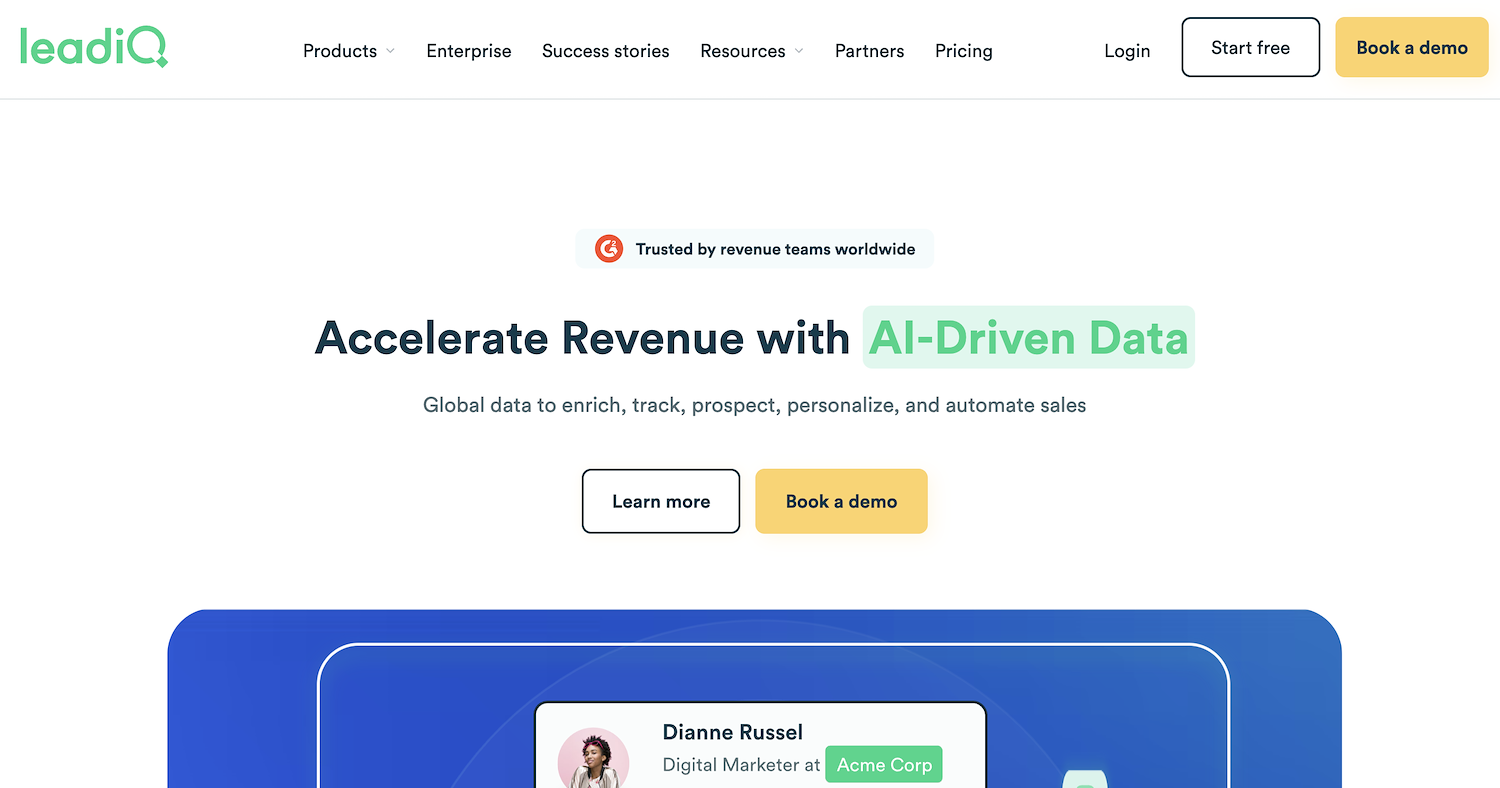
LeadIQ is a prospecting platform to find and capture contact data. Sales teams use it to get verified emails and phone numbers from sources like LinkedIn and company websites without a break in their workflow.
The tool helps research accounts and track sales triggers such as job changes. All captured information syncs directly to a CRM, which keeps the sales process in one place.
LeadIQ's Main Features
- Finds and captures prospect data from sources like LinkedIn.
- Tracks sales triggers, such as job changes, to help time outreach.
- Personalizes cold outreach messages to prospects at scale.
- Syncs captured lead data directly to CRMs and sales engagement platforms.
How LeadIQ Compares to Surfe
Average Review score: 4.2/5 stars based on 1,097 G2 reviews.
- LeadIQ tracks sales triggers, such as when a prospect changes jobs, to help with outreach timing. This is different from Surfe, which focuses on syncing the contact data available at a single point in time.
- It provides a free plan for individual users with a limited number of credits. This makes it more accessible for small-scale use compared to Surfe, which does not offer a free version.
- The tool helps personalize cold outreach messages at scale. Surfe, in comparison, is primarily a data bridge to a CRM and does not include built-in outreach personalization features.
- This platform syncs captured data directly to sales engagement platforms in addition to CRMs. This offers a more specific integration path than Surfe's direct-to-CRM sync.
LeadIQ’s Drawbacks Compared To Surfe
- LeadIQ's workflow can feel less integrated within LinkedIn compared to Surfe. Some users note its browser extension is sometimes slow, while Surfe operates entirely inside the LinkedIn interface for a more contained process.
- The platform's contact data comes from its own database, which may occasionally be out of date. In comparison, Surfe pulls information directly from live LinkedIn profiles, which are generally more current.
- It lacks built-in message templates that function directly on a LinkedIn profile page. Surfe includes this feature, which lets sales teams send messages without switching to another tool or tab.
Pricing and Plan Comparison
LeadIQ offers a free plan and paid tiers starting at $45 per user per month. This makes it a more accessible entry point than Surfe, which does not have a free version and whose plans are often considered steep for smaller teams.
Which One Should You Go With?
Choosing a Surfe alternative depends on many variables, from your team's workflow to your budget. This guide has outlined several options to help you make an informed decision.
If your goal is to move beyond manual data entry and automate entire sales functions, 11x offers a different approach. Its autonomous agents handle tasks like prospecting and outreach, allowing your sales team to focus on closing deals.




